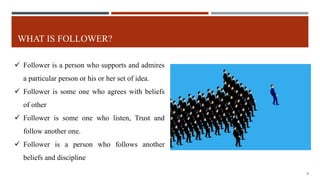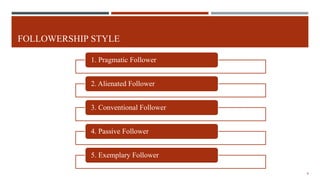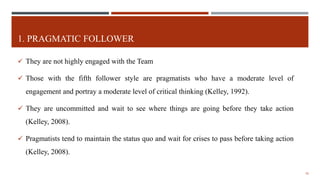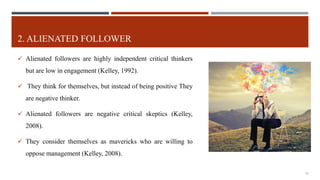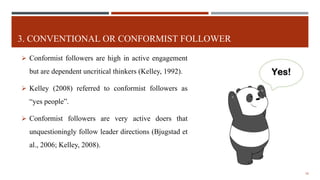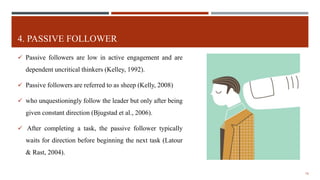Detail Presentation on Effective leadership and Followership
- 2. 2
- 3. 3 ’ā╝ Practice openness ’ā╝ Demonstrate competence or responsibility ’ā╝ Maintain confidence ’ā╝ Fulfill your promises ’ā╝ Show consistency ’ā╝ Tell the truth ’ā╝ Speak your feelings ’ā╝ Be fair Building Trust
- 4. 4 NURTURING CLIMATE Members of the organization must be able to work in a climate that is free of fear, one that fosters creativity and rewarding the achievements.
- 5. 5 FREEDOM OF EXPRESSION People must be able to talk with one another, share ideas, critique proposals, and obtain information that assists them in being effective.
- 6. 6 RESPECT EACH OTHER FOR DIVERSITY In order for people to make a commitment to the attainment of a particular goal, they need to feel valued, respected and appreciated.
- 7. 7 TEACH A COURSE WHAT DO FOLLOWERS WANT Feeling of significance ŌĆ£I really matterŌĆØ Feeling of community unity of purpose Leaders should be: Honest Forward thinking Inspiring competent Colleagues should be: Honest Cooperative Dependable competent
- 8. 8 WHAT IS FOLLOWER? ’ā╝ Follower is a person who supports and admires a particular person or his or her set of idea. ’ā╝ Follower is some one who agrees with beliefs of other ’ā╝ Follower is some one who listen, Trust and follow another one. ’ā╝ Follower is a person who follows another beliefs and discipline
- 9. 9 FOLLOWERSHIP STYLE 1. Pragmatic Follower 2. Alienated Follower 3. Conventional Follower 4. Passive Follower 5. Exemplary Follower
- 10. 10 1. PRAGMATIC FOLLOWER ’ā╝ They are not highly engaged with the Team ’ā╝ Those with the fifth follower style are pragmatists who have a moderate level of engagement and portray a moderate level of critical thinking (Kelley, 1992). ’ā╝ They are uncommitted and wait to see where things are going before they take action (Kelley, 2008). ’ā╝ Pragmatists tend to maintain the status quo and wait for crises to pass before taking action (Kelley, 2008).
- 11. 11 2. ALIENATED FOLLOWER ’ā╝ Alienated followers are highly independent critical thinkers but are low in engagement (Kelley, 1992). ’ā╝ They think for themselves, but instead of being positive They are negative thinker. ’ā╝ Alienated followers are negative critical skeptics (Kelley, 2008). ’ā╝ They consider themselves as mavericks who are willing to oppose management (Kelley, 2008).
- 12. 12 3. CONVENTIONAL OR CONFORMIST FOLLOWER ’āś Conformist followers are high in active engagement but are dependent uncritical thinkers (Kelley, 1992). ’āś Kelley (2008) referred to conformist followers as ŌĆ£yes peopleŌĆØ. ’āś Conformist followers are very active doers that unquestioningly follow leader directions (Bjugstad et al., 2006; Kelley, 2008).
- 13. 13 4. PASSIVE FOLLOWER ’ā╝ Passive followers are low in active engagement and are dependent uncritical thinkers (Kelley, 1992). ’ā╝ Passive followers are referred to as sheep (Kelly, 2008) ’ā╝ who unquestioningly follow the leader but only after being given constant direction (Bjugstad et al., 2006). ’ā╝ After completing a task, the passive follower typically waits for direction before beginning the next task (Latour & Rast, 2004).
- 14. 14 5. EXEMPLARY FOLLOWER ’āś Exemplary followers rank high in both active engagement and independent critical thinking. ’āś Exemplary followers think for themselves and are therefore willing to challenge leaders by providing alternative solutions if they disagree with the leader (Kelley, 1992). ’āś They proactively support organizational goals and leader decisions that are congruent with their beliefs (Kelley, 1992). ’āś Exemplary followers ŌĆ£assume responsibilities beyond their minimum job requirements and exert considerable effort to accomplish goalsŌĆØ (Blanchard et al., 2009, p. 112-113). ’āś Finally, exemplary followers work well with others (Bjugstad et al., 2006).
- 15. 15 CONTINGENCY THEORY It is is an organizational theory that claims that there is no best way to organize a corporation, to lead a company, or to make decisions. Instead, the optimal course of action is contingent (dependent) upon the internal and external situation. Contingent leaders are flexible in choosing and adapting to succinct or short strategies to suit change in situation at a particular period in time in the running of the organization.
- 16. 16 TRAITS OF A LEADER ’éĪ Vision ’éĪ Ability ’éĪ Honor ’éĪ Stability ’éĪ Concern for others ’éĪ Self confidence ’éĪ Persistence ’éĪ Vitality / Power ’éĪ Charisma ’éĪ Integrity
- 17. 17 TRAITS OF A LEADER Vision: A leader requires a strong sense of purpose: ŌĆó Clear concept of collective vision (organization) ŌĆó Recognize what must be done ŌĆó Inspire others Ability: ŌĆó Leaders must know the job Enthusiasm or Honor: ŌĆó Important trait of a leader: leaders always create excitements. ŌĆó This excitement can trigger the goal oriented actions Stability: Leaders should: ŌĆó Posses objectivity ŌĆó Should not bring personal problems to work ŌĆó Be emotionally stable Concern for others: ŌĆó The heart of caring leadership Self Confidence: Gives the leader inner strength to overcome tasks ŌĆó Successful leaders stay calm and confident ŌĆó Show confidence in actions ŌĆó Build self confidence
- 18. 18 TRAITS OF A LEADER Persistence: Determination of a leader is also very important. ŌĆó Important for business success. Vitality: Leaders need strength/energy and stamina ŌĆó Effective leaders are electric, vigorous, active and full of life, regardless of age and disability. ŌĆó To achieve goals, leaders need stamina, energy, health and vigor. Charisma: Personality trait. ŌĆó A quality that generates otherŌĆÖs interest and creates followers. Integrity: The most important quality of leadership ŌĆó Honest, strength of character and courage
- 19. THANK YOU!
Editor's Notes
- #7: Project Control┬Āis a work process of the developing plans, measuring the actual performance, and creating reports for the project schedule, cost and resources by data gathering, status analysing, comparing actual performance with planned, and communicating with project teams to support right and effective decision making. The Project Controls need a forecasting ability, developing corrective action, and change management.
- #17: Persistence ŌĆō ┘ģ┘鞦┘ł┘ģž¬ ž¦ž│ž¬ž¦ž»┘ć Charisma = Attractiv Integrity - Trust








